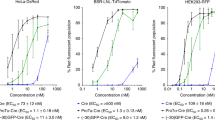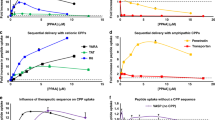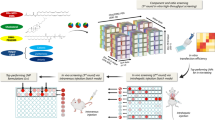Abstract
Development of nonviral delivery systems is progressing toward a transfection efficiency sufficient to affect metabolic and neoplastic diseases in humans. Nevertheless, inadequate transfection efficiency of target cells with current nonviral systems still limits the utility of this therapy. In the current study, we have determined that a co-polymer of histidine and lysine (H-K) enhances the transfection efficiency of liposomes, a leading nonviral system. We found that in the absence of serum, the addition of this polymer increased transfection as much as 10-fold in comparison with the liposome:DNA complex alone. More impressively, the co-polymer in the presence of serum increased transfection efficiency up to 100-fold. Furthermore, in vivo expression of luciferase in a tumor increased 15-fold with the addition of H-K polymer to the liposome:plasmid DNA complexes. Without liposomes, the H-K polymer had little to no effect on transfection efficiency. We anticipate that further modifications of this co-polymer will yield molecules with both increased complexity and transfection efficiency.
This is a preview of subscription content, access via your institution
Access options
Subscribe to this journal
Receive 12 print issues and online access
$259.00 per year
only $21.58 per issue
Buy this article
- Purchase on Springer Link
- Instant access to full article PDF
Prices may be subject to local taxes which are calculated during checkout






Similar content being viewed by others
References
Felgner PL et al. Lipofection: a highly efficient, lipid-mediated DNA transfection procedure Proc Natl Acad Sci USA 1987 84: 7413–7417
Behr JP, Demeneix B, Loeffler JP, Perez-Mutul J . Efficient gene transfer into mammalian primary endocrine cells with lipopolyamine-coated DNA Proc Natl Acad Sci USA 1989 86: 6982–6986
Remy JS, Sirlin C, Vierling P, Behr J-P . Gene transfer with a series of lipophilic DNA-binding molecules Bioconjugate Chem 1994 5: 647–654
Nabel GL et al. Direct gene transfer with DNA liposome complexes in melanoma expression, biological activity, and lack of toxicity in humans Proc Natl Acad Sci USA 1993 90: 11307–11311
Zhu N, Ligitt D, Liu Y, Debs R . Systemic gene expression after intravenous DNA delivery into adult mice Science 1993 261: 209–211
Thierry AR et al. Systemic gene therapy: biodistribution and long-term expression of a transgene in mice Proc Natl Acad Sci USA 1995 92: 9742–9746
Marshall J . The trouble with vectors Science 1995 269: 1051–1055
Xu M et al. Parenteral gene therapy with p53 inhibits human breast tumors in vivo through a bystander mechanism without evidence of toxicity Hum Gene Ther 1997 8: 177–185
Yang JP, Huang L . Overcoming the inhibitory effect of serum on lipofection by increasing the charge ratio of cationic liposome to DNA Gene Therapy 1997 4: 950–967
Liu F, Qi H, Huang L, Liu, D . Factor controlling the efficiency of cationic lipid-mediated transfection in vivo via intravenous administration Gene Therapy 1997 4: 517–523
Stewart MJ et al. Gene transfer in vivo with DNA–liposome complexes: safety and acute toxicity in mice Hum Gene Ther 1992 3: 267–275
Felgner JH et al. Enhanced gene delivery and mechanism studies with a novel series of cationic lipid formulations J Biol Chem 1994 269: 2550–2561
Liu Y et al. Factors influencing the efficiency of cationic liposome-mediated intravenous gene delivery Nat Biotechnol 1997 15: 167–173
Hong K, Zheng W, Baker A, Papahadjopoulos D . Stabilization of cationic liposome–plasmid DNA complexes by polyamines and poly(ethylene glycol)-phospholipid conjugates for efficient in vivo gene delivery FEBS Lett 1997 400: 233–237
Li S, Rizzo MA, Bhattacharya S, Huang L . Characterization of cationic lipid–protamine–DNA (LPD) complexes for intravenous gene delivery Gene Therapy 1998 5: 930–937
Gao X, Huang L . Potentiation of cationic liposome-mediated gene delivery by polycations Biochemistry 1996 35: 1027–1036
Sorgi FL, Bhattacharya S, Huang L . Protamine sulfate enhances lipid-mediated gene transfer Gene Therapy 1997 4: 961–968
Li S, Huang L . In vivo gene transfer via intravenous administration of cationic lipid-protamine-DNA (LPD) complexes Gene Therapy 1997 4: 891–900
Toncheva V et al. Novel vectors for gene delivery formed by self-assembly of DNA with poly (L-lysine) grafted with hydrophilic polymers Biochim Biophys Acta 1998 1380: 354–368
Legendre JY, Szoka FC Jr . Delivery of plasmid DNA into mammalian cell lines using pH-sensitive liposomes: comparison with cationic liposomes Pharm Res 1992 9: 1235–1242
Ogris M et al. The size of DNA/transferrin–PEI complexes is an important factor for gene expression in cultured cells Gene Therapy 1998 5: 1425–1433
Wolfert MA, Seymour LW . Chloroquine and amphipathic peptide helices show synergistic transfection in vitro Gene Therapy 1998 5: 409–414
Erbacher P, Roche AC, Monsigny M, Midoux P . Putative role of chloroquine in gene transfer into a human hepatoma cell line by DNA/lactosylated polylysine complexes Exp Cell Res 1996 225: 186–194
Zauner W et al. Glycerol and polylysine synergize in their ability to rupture vesicular membranes: a mechanism for increased transferrin-polylysine-mediated gene transfer Exp Cell Res 1997 232: 137–145
Budker V et al. pH-sensitive cationic liposomes: a new synthetic virus-like vector Nat Biotechnol 1996 14: 760–764
Nidome T et al. Binding of cationic-helical peptides to plasmid DNA and their gene transfer abilities into cells J Biol Chem 1997 272: 15307–15312
Boussif O et al. A versatile vector for gene and oligonucleotide transfer into cells in culture and in vivo: polyethylenimine Proc Natl Acad Sci USA 1995 92: 7297–7301
Kukowska-Latallo JF et al. Efficient transfer of genetic material into mammalian cells using Starburst polyamidoamine dendrimers Proc Natl Acad Sci USA 1996 93: 4897–4902
Remy JS, Behr JP . Gene transfer with multivalent synthetic vectors J Liposome Res 1996 6: 535–544
Haensler J, Szoka FC Jr . Polyamidoamine cascade polymers mediate efficient transfection of cells in culture Bioconjug Chem 1993 4: 372–379
Midoux P, Monsigny M . Efficient gene transfer by histidylated polylysine/pDNA complexes Bioconjug Chem 1999 10: 406–411
Chen QR, Kumar D, Stass SA, Mixson AJ . Liposomes complexed to plasmids encoding angiostatin and endostatin inhibit breast cancer in nude mice Cancer Res 1999 59: 3308–3312
Cayot P, Tainturier G . The quantification of protein amino groups by the trinitrobenzenesulfonic acid method: a reexamination Anal Biochem 1997 249: 184–200
Snyder SL, Sobocinski P . An improved 2,4,6-trinitrobenzene-sulfonic acid method for the determination of amines Anal Biochem 1975 64: 284–288
Sherf BA, Wood KV . Luminometry for in vivo and in vitro reporting of firefly luciferase Promega Notes 1993 44: 18–23
Acknowledgements
We are grateful to Drs Amy Fulton, Edward Highsmith, and Robert Malone for their careful reading and useful comments concerning the manuscript. This work was supported by the National Institutes of Health (CA70394) and the Karl C Dod Charitable Trust.
Author information
Authors and Affiliations
Rights and permissions
About this article
Cite this article
Chen, QR., Zhang, L., Stass, S. et al. Co-polymer of histidine and lysine markedly enhances transfection efficiency of liposomes. Gene Ther 7, 1698–1705 (2000). https://doi.org/10.1038/sj.gt.3301294
Received:
Accepted:
Published:
Issue Date:
DOI: https://doi.org/10.1038/sj.gt.3301294
Keywords
This article is cited by
-
Construction of peptide/plasmid DNA complexes for plant gene transfection via the basic leucine zipper domain
Polymer Journal (2024)
-
Vacuum/Compression Infiltration-mediated Permeation Pathway of a Peptide-pDNA Complex as a Non-Viral Carrier for Gene Delivery in Planta
Scientific Reports (2019)
-
Library screening of cell-penetrating peptide for BY-2 cells, leaves of Arabidopsis, tobacco, tomato, poplar, and rice callus
Scientific Reports (2018)
-
Gene introduction into the mitochondria of Arabidopsis thaliana via peptide-based carriers
Scientific Reports (2015)
-
Single histidine residue in head-group region is sufficient to impart remarkable gene transfection properties to cationic lipids: evidence for histidine-mediated membrane fusion at acidic pH
Gene Therapy (2003)



